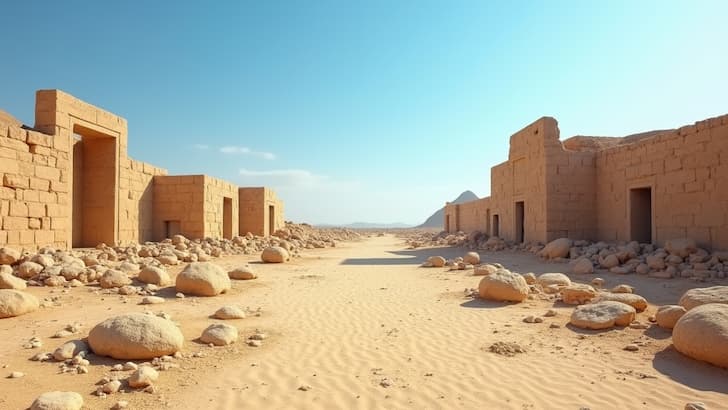Sodom vs Gomorrah: A Comparative Look at Ancient Biblical Cities
I have spent time digging into the accounts of Sodom and Gomorrah because these two ancient cities have drawn interest for centuries. Their stories appear in many old texts as examples of societies facing judgment from above. Over time, these narratives have influenced religious thought, cultural debates, and historical research. So here, I compare the two cities by examining their historical backgrounds, interpretations, and the lessons they offer for today.
Historical and Biblical Accounts
The stories of Sodom and Gomorrah have long been central to discussions about ancient civilization and moral standards. The narratives emphasize themes like hospitality, ethical behavior, and punishment from above. Here, I outline what historical records and biblical texts reveal about these cities.
What is Sodom?
Sodom appears in ancient records as a city noted for its serious moral challenges. Biblical texts describe it as a place where ethical norms were frequently defied. The narrative focuses on the city’s social practices and the consequences of its actions. Some sources hint that Sodom had a lively trade scene but also a reputation for neglecting traditional hospitality. Overall, the story of Sodom is layered, raising issues of social justice, community dynamics, and the idea of punishment for moral decline.
What is Gomorrah?
Gomorrah is mentioned alongside Sodom and shares similar themes. Biblical depictions show a city that fell from grace due to widespread ethical lapses. Like Sodom, Gomorrah is portrayed as a society where traditional values were largely abandoned. Archaeological research has sought remnants that might confirm these cities’ existence. Although physical evidence remains debated, most historians agree that both cities serve as cautionary tales about the dangers of moral decay.
Comparative Analysis of Cultural and Moral Dimensions
Comparisons between Sodom and Gomorrah focus on their social environments and moral climates. The analysis can be broken down into several key areas that illustrate how the two cities are portrayed in ancient texts.
1. Cultural Practices and Social Life
Both cities are shown as centers of social activity where communal rules were often ignored. Sodom is described with a strong emphasis on its neglect of hospitality, while Gomorrah is noted for its overall breakdown of community ethics.
These portrayals reflect the values of the authors, who believed that moral behavior was very important for a healthy society.
2. Judgment and Mercy
The theme of judgment from above is central to the stories of both cities. In many texts, a force from above is sent to address the moral failures of the people. Sodom’s account sometimes suggests a selective targeting of certain acts, while Gomorrah’s narrative presents a broader condemnation.
Both accounts prompt reflection on the balance between strict justice and mercy.
3. Archaeological Evidence and Historical Context
Archaeologists have long searched for physical evidence of these ancient cities. Excavations in regions associated with the narratives have uncovered settlement remains that may date back to the relevant period.
Although conclusions remain cautious, the possibility of ruins provides a tangible link to the accounts in the texts.
4. Legacy in Religious and Cultural Discussions
The stories of Sodom and Gomorrah have come to symbolize the consequences of ignoring established moral norms.
Many religious communities use these narratives to discuss themes like hospitality, social responsibility, and the ethics. The enduring nature of these lessons continues to shape modern debates on right and wrong.
5. Modern Interpretations and Symbolism
Today, theologians, historians, and cultural critics study these cities from different perspectives. Some view the accounts as literal historical events, while others consider them allegories warning against societal decay.
Each modern interpretation adds a valuable layer to our understanding of ethics and community responsibility.
Scholarly and Religious Interpretations
Debate continues about how to interpret the narratives of Sodom and Gomorrah. Various groups have provided insights that sometimes conflict but together enrich the discussion. Below are some of the major perspectives that influence modern understanding.
- Theological Perspectives: Many theologians stress the moral lessons in the stories, arguing that the extreme measures serve as a reminder of the consequences of straying from accepted ethical codes. They underline the importance of community values and personal accountability in social behavior.
- Historical-Critical Approaches: Scholars using historical-critical methods try to place the narratives in a broader context by seeking archaeological and historical evidence. They discuss how the accounts may have been shaped by the cultural and political factors of the time.
- Cultural Symbolism: Others see Sodom and Gomorrah as enduring symbols in literature and art. The downfall of these cities is used as a metaphor for societies that overlook ethical responsibilities, providing flexible lessons that resonate with contemporary issues.
- Scientific and Archaeological Analysis: While definitive proof of these cities remains elusive, scientific studies using earth sciences and excavation records continue to contribute insights. These efforts mix empirical research with historical critiques to offer plausible scenarios for the cities’ destruction.
Final Perspectives: Lessons and Legacy
After reviewing the accounts and interpretations, it is clear that Sodom and Gomorrah offer practical lessons on civic responsibility and the consequences of ignoring social norms. Their stories remind us that ethics and community values are rarely fixed and that shifts in societal behavior often have serious repercussions. Whether viewed as historical events or symbolic narratives, these accounts invite us to reflect on personal and communal responsibilities.
The discussion is not about choosing one narrative over another; it is about understanding that both texts warn us to examine our conduct and consider the implications of our actions. The focus on personal behavior and community welfare continues to resonate, prompting many to rethink how they engage with their values.
The legacy of these ancient cities is multifaceted. Their stories have stimulated scholarly debate, artistic expression, and personal reflection alike. Regardless of one’s interpretation, the cautionary tone of these narratives aligns with many of today’s discussions about ethics, community resilience, and balancing tradition with change.
Reflections and Discussion
Reflecting on these ancient narratives offers modern readers valuable insights. The tales of Sodom and Gomorrah, even if partly mythic, shed light on the importance of maintaining ethical behavior and a spirit of hospitality. They invite us to join a broader conversation about the challenges societies face when traditional values are eroded.
Debate persists over the historical accuracy and symbolic meaning of these accounts. Some focus on the punishment from above depicted in the texts, while others highlight the societal conditions that might have led to the cities' decline. Both viewpoints contribute to a richer understanding of how human behavior shapes communities.
This discussion is particularly relevant today as we seek ways to nurture cultures that value collective well-being without stifling individual freedoms. Ancient lessons remind us that modern ethical challenges have deep roots, and their solutions might benefit from historical perspective.
Public forums, academic gatherings, and religious communities continue to explore these narratives in varied ways. Such conversations underscore the importance of questioning past events to gain wisdom for current challenges.
Ultimately, the lasting impact of the Sodom and Gomorrah narratives lies in their ability to provoke thought and inspire self-examination. Reflecting on these stories encourages us to consider our roles within our communities and to act in ways that sustain societal well-being.
What aspects of the stories of Sodom and Gomorrah do you find most thought provoking? I invite readers to share their insights on how these narratives continue to influence discussions on ethics and community life.






Your Sodom vs. Gomorrah post is absolutely brilliant! The way you blend biblical narratives with historical context is captivating, bringing these ancient cities vividly to life. Your insights on divine justice are uplifting and thought-provoking. I learned a lot. Thank you for this incredible piece – it’s deepened my faith and understanding. I’m sharing this with my Bible study group, who’ll love its clarity and passion. Keep producing such well-researched, heartfelt content. Can’t wait for your next post! Your work is a true blessing to readers like me.
Hello, thanks for your comment. Your enthusiasm is heartwarming. I’m thrilled the post resonated and deepened your faith. The “wise protector” is one of those kinds, I aim to guide through truth. Thanks for sharing with your group! More to come – stay blessed!
Your post content is too narrow. It leans heavily on biblical accounts but glosses over archaeological evidence or alternative historical views. The moralizing feels preachy, and the lengthy tangents slow the pace. Thank you for trying, but critical readers need more balance. Why not explore secular sources or address debates about the cities’ sins, like inhospitality versus sexual immorality? The topic demands nuance, not just faith-based conclusions. I hope future posts offer broader research and less sermonizing. A more rigorous approach would make your analysis stronger and more credible.
Hi,thanks for the honest feedback. I focus on biblical perspectives but see your point about needing balance. I’ll consider incorporating secular sources and addressing debates in future posts. Your critique helps me grow—appreciate it! Stay tuned for more nuanced content.
Thank you for your article. This post is beautifully written and deeply thought-provoking. The way you explore the cities’ sins and their divine punishment invites reflection on human nature and justice. The historical details add such richness. Thank you for this profound work—it’s a gift to those seeking wisdom. I found myself pondering modern parallels to the pride and apathy you describe. Your gentle yet clear tone feels like a conversation with a trusted mentor. Please continue sharing these insightful pieces; they’re a treasure for contemplative readers like me.
Hi Ben, your kind words are truly touching! I’m glad the post sparked reflection—it’s my goal to share wisdom. Your mentorship comparison warms my heart. More thoughtful content is on the way. Thank you for your support.